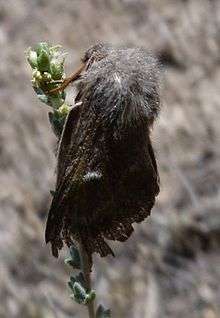Psilogaster
Psilogaster is a monotypic moth genus in the family Lasiocampidae first described by Reichenbach in 1817.[2] Its only species, Psilogaster loti, described by Ferdinand Ochsenheimer in 1810, is found in south-western Europe and North Africa.[3]
| Psilogaster loti | |
|---|---|
 | |
.jpg) | |
| Scientific classification | |
| Kingdom: | |
| Phylum: | |
| Class: | |
| Order: | |
| Family: | |
| Genus: | Psilogaster Reichenbach, 1817 |
| Species: | P. loti |
| Binomial name | |
| Psilogaster loti (Ochsenheimer, 1810)[1] | |
| Synonyms | |
|
Genus:
Species:
| |
The larvae feed on Cistus salvifolius, Cistus albidus, Cistus populifolius, Cistus ladanifer, Cistus laurifolius, Cistus clusii and possibly Rosmarinus officinalis and Helianthemum.
Subspecies
- Psilogaster loti loti
- Psilogaster loti algeriensis Baker, 1885 (Morocco to Libya)
- Psilogaster loti simulatrix Chrétien, 1910 (Tunisia, Libya)
gollark: >daily
gollark: Retroactively done.
gollark: There aren't any. GTech has... whatever you were talking about, I forgot... contained.
gollark: ++remind 1d-5m >daily regardless of what heavpoot says
gollark: >daily
References
- Fauna Europaea
- Nomen.at
- Savela, Markku. "Psilogaster Reichenbach, 1817". Lepidoptera and Some Other Life Forms. Retrieved September 16, 2018.
- Lepiforum.de
| Wikimedia Commons has media related to Psilogaster. |
| Wikispecies has information related to Psilogaster loti |
This article is issued from Wikipedia. The text is licensed under Creative Commons - Attribution - Sharealike. Additional terms may apply for the media files.